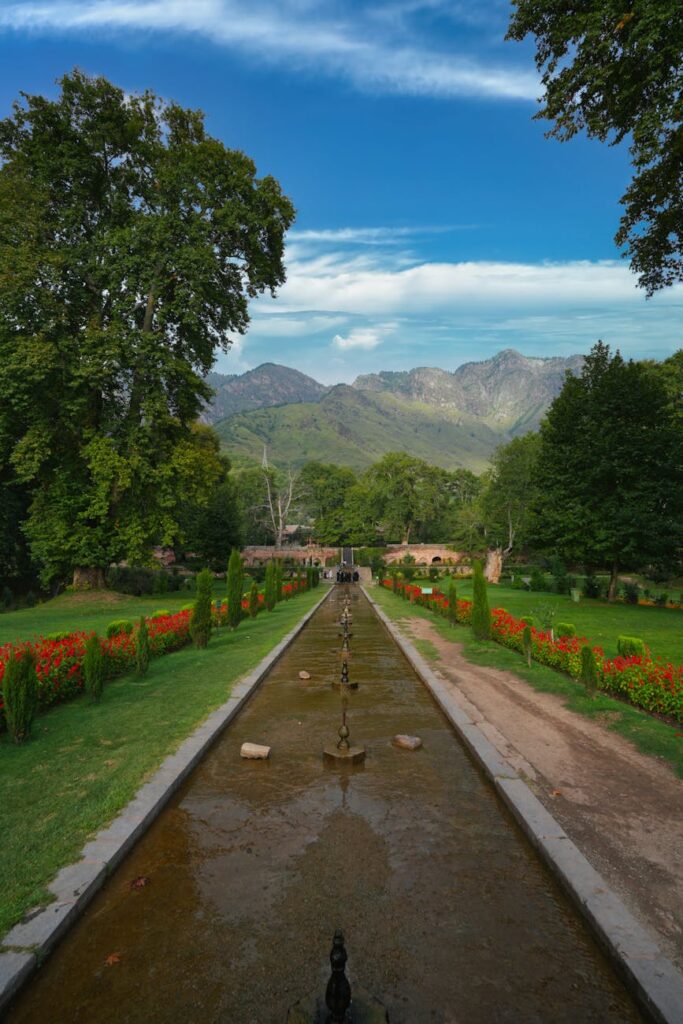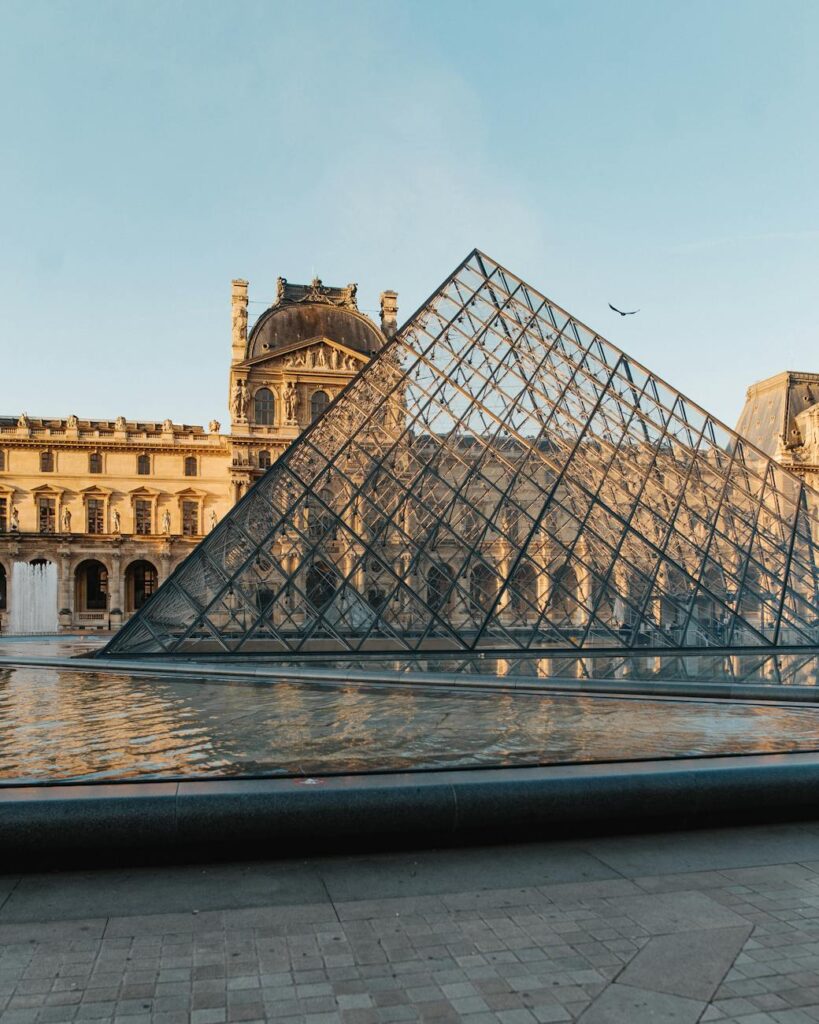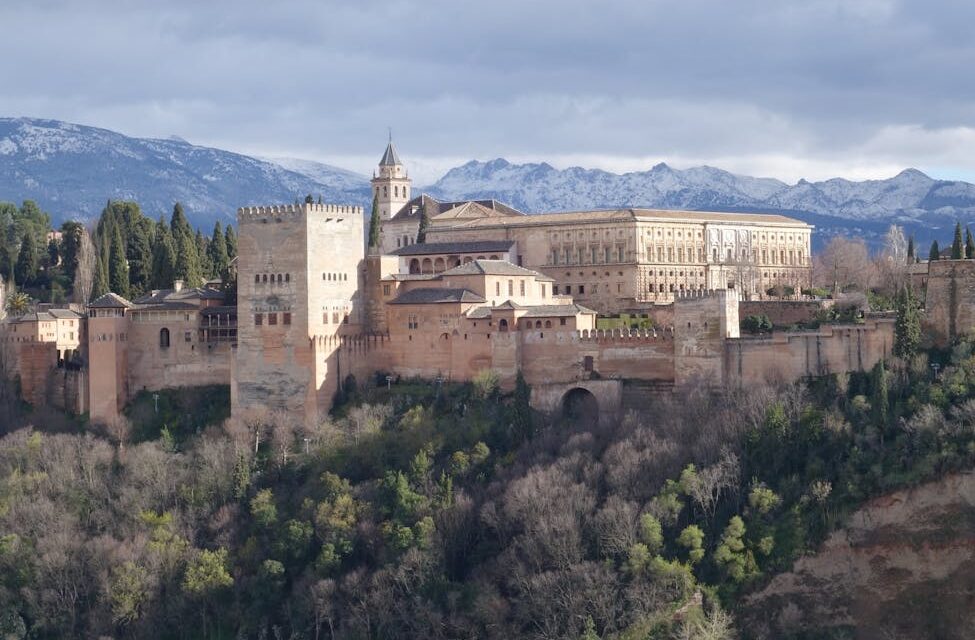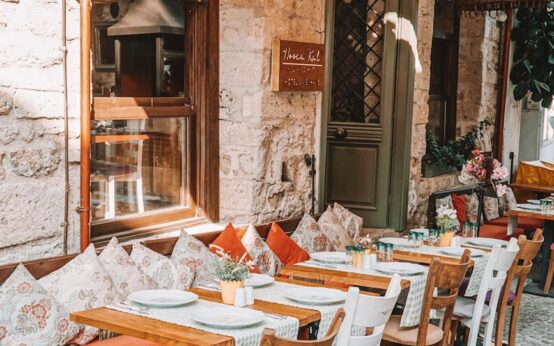Step Through a Gate, and the World Changes
Have you ever stepped out of a noisy, chaotic city street and into a space so perfectly ordered and serene that your shoulders instantly drop? Your breathing slows. The air feels cooler, scented with jasmine and damp earth. This is the magic of Islamic gardens. They are more than just pretty collections of plants; they are meticulously designed sanctuaries, earthly echoes of a heavenly paradise. For centuries, these gardens have been spaces for contemplation, relaxation, and a deep connection with nature, all built around a core principle: the profound, calming power of symmetry.
Forget the wild, untamed look of an English cottage garden or the minimalist raked sand of a Zen garden. Islamic garden design is a masterclass in geometric precision, a conversation between mathematics and nature. It’s a tradition that has stretched across continents and centuries, from the courtyards of the Alhambra in Spain to the magnificent grounds of the Taj Mahal in India. What connects them all is a shared design language that speaks of order, reflection, and the life-giving importance of water. It’s a design philosophy that creates not just a place, but a feeling—a deep, resonant sense of peace.
Key Takeaways:
- Islamic gardens are designed as earthly representations of paradise (Jannah), as described in the Quran.
- The core design principle is often the ‘Charbagh’ or four-part layout, symbolizing the four rivers of paradise.
- Water is the central, most crucial element, used in channels, fountains, and pools for its cooling, reflective, and symbolic properties.
- Symmetry, geometry, and enclosure create a sense of order, peace, and protection from the outside world.
- These gardens are multi-sensory experiences, incorporating sound, scent, and even taste alongside visual beauty.
What Truly Defines Islamic Gardens?
So, what makes a garden an “Islamic” garden? It’s not about a specific set of plants or a particular climate. It’s a philosophy. At its heart, the design is a conscious effort to create a paradise on Earth—a Jannah. The Quran is filled with evocative descriptions of paradise as a lush, beautiful garden, watered by flowing rivers, filled with fruit-bearing trees and fragrant flowers. Islamic garden designers took these descriptions as their blueprint.
The first defining feature is enclosure. Almost all traditional Islamic gardens are walled. This isn’t just for privacy; it serves a practical purpose in hot, arid climates, protecting the delicate plants from harsh winds and sun. But more importantly, it creates a psychological boundary. Crossing the threshold of the wall is like leaving the chaotic, profane world (dunya) and entering a sacred, ordered space. It’s an intentional separation that allows for quiet contemplation.
The second feature is the rigorous use of geometry and symmetry. The layout is never random. Paths are straight, flowerbeds are often laid out in geometric patterns, and everything reflects and balances. This order is not just for aesthetics; it reflects a worldview of a structured, divinely ordered universe. It’s the opposite of chaos. It’s control, harmony, and balance made visible.
The Four-Part Plan: Understanding the Charbagh
If there’s one layout that defines the classic Islamic garden, it’s the Charbagh (or Chahar Bagh). The term is Persian for “four gardens.” It’s a quadrilateral layout, divided by walkways or, more importantly, water channels into four smaller parts. It is astonishingly simple and profoundly symbolic.

The central point where the two axes cross is almost always marked by a fountain or a pool. This is the heart of the garden, the source from which life, in the form of water, flows out to nourish the four quarters. This layout is a direct reference to the Quranic description of the four rivers of paradise: one of water, one of milk, one of wine, and one of honey. Stepping into a Charbagh garden is, in a very real sense, stepping into a living, breathing diagram of paradise.
This design is incredibly versatile. It can be scaled up to the immense size of the gardens surrounding the Taj Mahal or scaled down to the intimate size of a private courtyard in a riad. The principle remains the same. The four-part division creates an immediate sense of harmony and orientation. Your eye knows where to go. Your body understands the logic of the space. It’s this inherent, easy-to-understand order that contributes so much to the garden’s calming effect.
The Soul of the Garden: The Critical Role of Water
You simply cannot talk about Islamic gardens without talking about water. In the desert cultures where this garden style originated, water wasn’t just a resource; it was life itself. It was the ultimate symbol of purity, blessing, and divine grace. Its presence in a garden transformed a simple patch of land into an oasis, a miracle of life and abundance.
Water is used in three primary ways, each engaging the senses differently:
- Channels (Rills): These are narrow, shallow channels, often lined with beautiful tiles, that carry water through the garden. They are the garden’s arteries. They guide the eye, divide the space, and create a gentle, murmuring soundtrack. The sound of trickling water is a constant, soothing presence that masks any noise from the outside world. It’s a sound that promises coolness and life.
- Fountains: A jet of water arching into the air is a celebration. It’s a display of control over this precious element. The splash and spray cool the air through evaporation, a natural form of air conditioning. A central fountain often acts as the focal point of the entire garden, a bubbling heart from which all the channels flow.
- Pools: A still, reflective pool is the garden’s soul. It serves as a mirror, capturing the sky, the clouds, and the surrounding architecture. This creates a powerful sense of depth and a connection between the earth and the heavens. Gazing into a reflection pool is an act of contemplation, a moment of perfect stillness where the world above and the world below become one.
The clever engineering behind these water features, often relying solely on gravity, is a testament to the scientific and artistic achievements of the cultures that built them. They weren’t just decorative; they were a sophisticated system for irrigation and climate control.

A Symphony for the Senses: Plants, Scent, and Sound
While the geometry provides the structure, it’s the plant life that fills the garden with vitality. The planting choices are rarely accidental. They are selected to create a multi-sensory experience that goes far beyond the visual.
Shade and Structure: Trees are essential. Cypress trees, with their tall, slender form, provide vertical accents and represent eternity. Fruit trees like pomegranate, fig, citrus, and date palms were beloved not just for their shade but for their bounty—a tangible taste of paradise. The shade from a large plane tree or a vine-covered pergola creates a cool, inviting pavilion, a place to sit and escape the heat.
Scent: This is perhaps one of the most transportive elements. Fragrance was paramount. Night-blooming jasmine, intoxicating roses, fragrant citrus blossoms—these were planted near walkways and seating areas so their scent would perfume the air, especially in the cool of the evening. Scent is tied so closely to memory and emotion, and these gardens were designed to leave a lasting, beautiful impression.
Color and Sound: While not riotously colorful like a perennial border, color was used strategically. Brightly colored flowers like tulips and irises might be planted in geometric beds, and the vibrant blues, greens, and yellows of ceramic tiles (zellige) on fountains and walls would provide permanent color, sparkling in the sun. And let’s not forget sound. Beyond the water, the gardens were designed to attract birds. The sound of birdsong, mixed with the gentle burble of a fountain, is the quintessential soundtrack to these tranquil spaces.
“The garden becomes a protected, enclosed space, a metaphor for the spiritual life that must be cultivated and protected from the distractions of the outside world. Every element, from the flow of water to the scent of a rose, is a reminder of divine generosity.”
Famous Examples of Islamic Gardens You Can Visit
The best way to understand the power of these gardens is to experience them. While many historic gardens have been lost, some of the world’s most beautiful examples remain, welcoming visitors to this day.
The Alhambra and Generalife, Spain
Perhaps the most famous Islamic palace in the world, the Alhambra in Granada is a masterpiece of Moorish art and architecture. Its gardens, particularly the Court of the Myrtles with its vast reflecting pool and the Court of the Lions with its intricate fountain, are legendary. A short walk away are the Generalife gardens, the summer palace of the Nasrid rulers. Here, the gardens are the main event. The Patio de la Acequia (Court of the Water Channel) is a breathtaking example of water used for both beauty and function, with jets of water arching over a long central pool.
The Taj Mahal, India
While the mausoleum itself is the star, the vast Charbagh garden that precedes it is an essential part of the experience. It sets the stage for the building, providing a perfect, symmetrical frame. The long reflecting pool that runs down the central axis creates the iconic reflection that everyone wants to photograph. It’s a powerful statement, a path leading the soul from the earthly garden towards the divine monument. It’s a Mughal garden on the grandest possible scale.
Shalimar Garden, Pakistan
Located in Lahore, this UNESCO World Heritage site is a stunning example of Mughal garden design. Built by Emperor Shah Jahan (the same man behind the Taj Mahal), it’s a terraced garden, which allows for beautiful cascades and waterfalls between the levels. It features over 400 fountains, and when they are all running, it’s a truly spectacular sight. It was designed not just for beauty but for royal life, with pavilions and halls for audiences and private relaxation.

Conclusion: A Timeless Blueprint for Tranquility
In our modern, often chaotic world, the principles of Islamic gardens feel more relevant than ever. They remind us of the deep human need for order, for sanctuary, and for a meaningful connection with nature. They show us that a garden can be more than a hobby or a patch of green; it can be a space for spiritual renewal, a place designed to calm the mind and soothe the soul. The perfect symmetry isn’t sterile or rigid; it’s a framework for peace. The sound of water isn’t just background noise; it’s a cleansing mantra. These gardens are a timeless blueprint for creating paradise, however small, in our own corner of the world.
FAQ
What is a ‘Charbagh’ garden?
A Charbagh is a classic Islamic garden layout based on a four-part design. It’s a quadrilateral garden divided by water channels or walkways into four smaller squares or rectangles. This layout is highly symbolic, representing the four rivers of paradise (Jannah) as described in the Quran.
Why is water so important in Islamic gardens?
Water is the central element because it symbolizes life, purity, and divine blessing, especially in the arid regions where this garden style originated. It serves multiple purposes: practical (irrigation and cooling), aesthetic (reflection and sound), and symbolic (representing the rivers of paradise).
Are all Islamic gardens the same?
No. While they share core principles like enclosure, geometry, and the importance of water, Islamic gardens show incredible regional variation. A Mughal garden in India, with its terraced layout, will feel different from a Moorish courtyard garden in Spain or a Persian garden with its intricate pavilions. The local climate, culture, and available plants all influence the final design.



 Faroe Islands: Guide to its Untamed, Serene Beauty
Faroe Islands: Guide to its Untamed, Serene Beauty  Discover the Joy of an Early Morning Walk in the City
Discover the Joy of an Early Morning Walk in the City  Best Plein Air Painting Destinations | Artist’s Guide
Best Plein Air Painting Destinations | Artist’s Guide  World’s Most Beautiful Greenhouses: A Visitor’s Guide
World’s Most Beautiful Greenhouses: A Visitor’s Guide  Birdwatching for Travelers: A Calming Hobby on the Go
Birdwatching for Travelers: A Calming Hobby on the Go  How to Find a Secluded Hot Spring (Away From Crowds)
How to Find a Secluded Hot Spring (Away From Crowds)  AI and Blockchain: A Powerful Tech Synergy
AI and Blockchain: A Powerful Tech Synergy  Get a Job in Blockchain: Your 2024 Web3 Career Guide
Get a Job in Blockchain: Your 2024 Web3 Career Guide  Wallet Types Explained: Hot vs Cold & More (2024 Guide)
Wallet Types Explained: Hot vs Cold & More (2024 Guide)  How Venture Capital is Shaping the Crypto Industry
How Venture Capital is Shaping the Crypto Industry  Sentiment Analysis for Crypto: A Trader’s Ultimate Guide
Sentiment Analysis for Crypto: A Trader’s Ultimate Guide  NFTs: The New Key to Membership & Brand Loyalty | Guide
NFTs: The New Key to Membership & Brand Loyalty | Guide